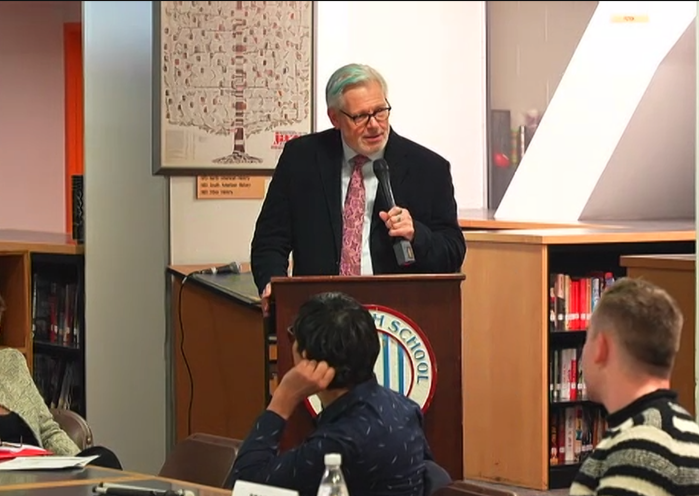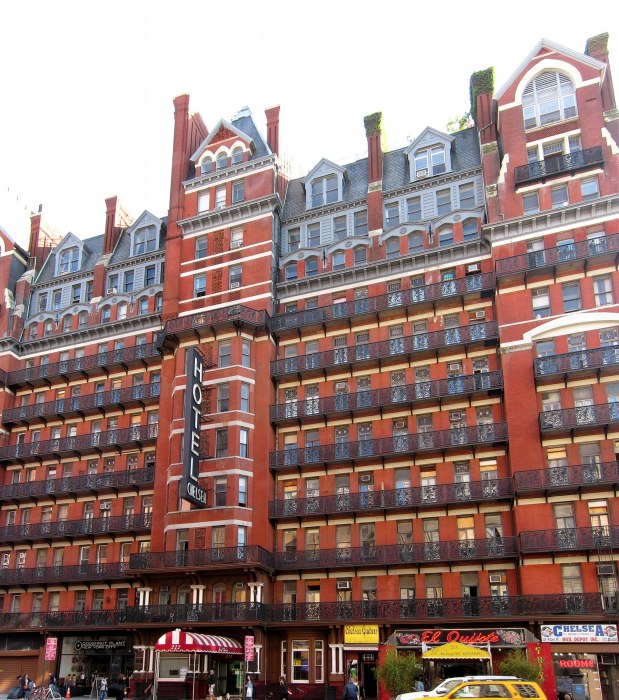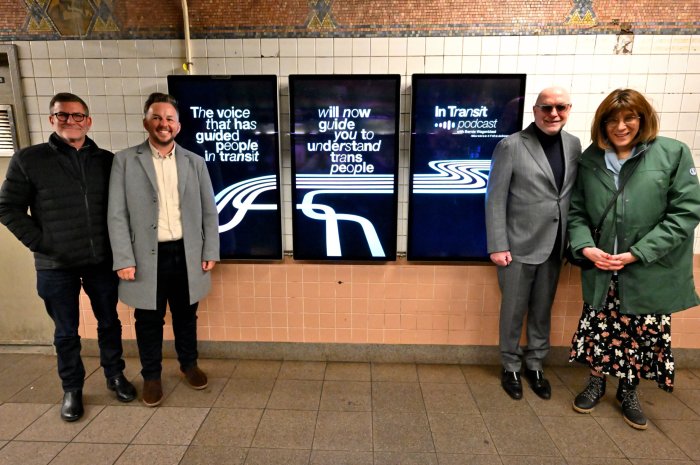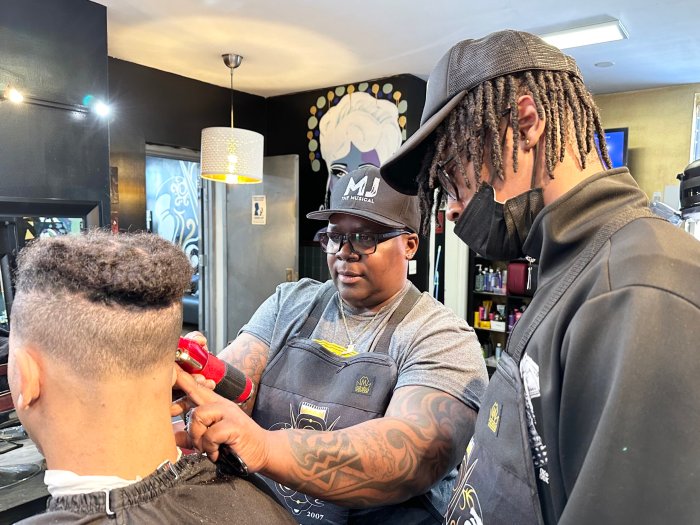Following his arrest on the High Line for selling art without a permit on Nov. 21, street-artist activist Robert Lederman is now working on his latest creation — a lawsuit for millions in damages that he plans to file against the Friends of the High Line and the city.
Meanwhile, the Friends of the High Line and the Parks Department are both being tight-lipped, refusing to simply say whether it’s legal or illegal to vend art without a permit on the new elevated park.
After being hauled off the High Line in handcuffs, Lederman was held in a cell at the Sixth Precinct on W. 10th St. for three hours before being released.
He’s no stranger to arrests. Between 1994 and 2001, he was busted 41 times. Lederman said that, during those years — especially when he was “targeted by Giuliani” for expressing his First Amendment right to sell art — he expected to be arrested when he was vending on the street or when he “led all those hundreds of protests.”
At the protests, Lederman would brandish his paintings of Giuliani depicted as Hitler, Nero or other infamous historical dictators.
At a turning point, in 2001, Lederman and 60 other street artists won a landmark case (Lederman et al. v Giuliani) upholding their right to vend in front of the Metropolitan Museum of Art without needing any Parks permits; under the sweeping ruling and settlement, the order was also applied to all New York City public parks.
Lederman’s arrest last month was his first since winning the decisive legal battle eight years ago.
He denied he was trying to get arrested, and said he wasn’t even anticipating it.
“I wasn’t there expecting anything else than a pleasant day to sell my art,” he asserted.
Though the High Line park is run by a conservancy in the Friends of the High Line, it’s still a New York City-owned, public park, like any other. So, Lederman said, the court ruling allowing art vending obviously applies.
As Lederman, who lives in New Jersey, tells it, it all started simply enough as an outing to Soho, where he planned to set up his sidewalk display and sell his artwork. He said it was a “fluke” he ended up on the High Line — his first visit ever to the cutting-edge park.
“I tried to find a spot to park in Soho, but I couldn’t find one because of all the new bike lanes,” he said.
He then drove over to the Meatpacking District, planning to vend by the new Apple Store, he said, when he noticed a sign for an elevator going up to the High Line, and decided to check out the new park he had been reading so much about.
He set up his regulation-size display in what he called “a discreet spot” on the High Line at 14th St. and 10th Ave., along the side of the park’s pathway.
“I took pains not to stand in the spot with the best views,” he noted.
His display is made of cardboard and is like a folding room screen: At 1 foot deep, 5 feet long and 6 feet tall, it’s slightly smaller than the city’s allowed dimensions for vendor stands.
“I’m allowed 3 feet [deep],” Lederman noted, plus the stand can be 8 feet tall.
Attached to the display were his artwork — paintings and prints of New York City scenes and jazz musicians, going for $20 to $40 — plus newspaper articles from The New York Times and New York Post on his victories against the city in his vending-rights lawsuits.
Lederman said just 30 seconds after he had erected his display around 9 a.m., he was confronted by a High Line staff member. A few minutes later, he was surrounded by eight of them.
“All of them had High Line uniforms with High Line logos on them, baseball caps with High Line logos and walkie-talkies with High Line logos,” he said.
According to Geoffrey Croft, of NYC Park Advocates, an outspoken critic of the new park, these employees are known as High Line Rangers, and are paid for by Friends of the High Line.
Croft forwarded to Chelsea Now a response from Patrick Cullina, the High Line’s vice president of horticulture and park operations, regarding Croft’s questions about the High Line Rangers:
“Their purpose is to ensure the safety of the High Line’s visitors by monitoring the park’s capacity — currently 1,700, dictated by Buildings Department statute,” Cullina said. “They are trained to provide a friendly, welcoming experience to all of our visitors… .”
For the first hour, Lederman said, these Rangers “harangued” him, ordering him to pack up his art and get off the High Line. After he didn’t leave, for the next five hours they just walked by him silently.
“People were delighted to see me there,” Lederman said. “Hundreds of people looked at my art.” A smaller number stopped and talked to him, he said, adding that, at most, there were only two parkgoers around his stand at any one time.
Then at 3:30 p.m., a city Park Enforcement Patrol officer, whose nameplate read “B. Joseph” issued Lederman three noncriminal Environmental Control Board summonses: for disorderly conduct; “failure to comply with a direction prohibition on sign”; and “unauthorized/failure to have display comply with required permit.”
The eight High Line Rangers stood watching about 20 feet away, Lederman said.
“I told him I have a right to vend, and I don’t have a permit,” the artist activist said.
He showed the officer the newspaper articles on his lawsuit victories, and said the officer “seemed to believe it himself,” yet still wrote the tickets.
The PEP finally handcuffed him after he wouldn’t go away. Many tourists witnessed the arrest, Lederman added, noting some were standing with their “mouths open” in concern, as the officer and Rangers wrongly warned them it was illegal to videotape the arrest.
The artist claimed the PEP officer was rough on him.
“He was trying to break my arm,” said Lederman, 59.
The PEP took Lederman to the Sixth Precinct, where, according to the artist, a lieutenant whose name he didn’t catch told the PEP that Lederman actually did have the right to vend art in the park. He was put in a holding cell at the precinct, sharing it with “a guy with two felony drug convictions.” But Lederman said the Parks Department officer was handling the arrest, and that the police basically weren’t involved. The PEP wrote up a couple of more summonses against Lederman — criminal charges this time.
Andy Stimus, a Sixth Precinct community affairs officer, stated, “He was issued two summonses here at the precinct by Parks Enforcement: one for disorderly conduct and one for disobeying park regulations. He was released within a matter of hours, and that’s it — Parks Enforcement handled the entire situation.”
Lederman said the whole experience of “being dragged to jail in handcuffs” has left him feeling “stressed.” Although he had been arrested 41 times before, he said, “It’s never pleasant, and this was a total shock and outrage.
“I would think it wouldn’t take a lot of training to teach people that it’s legal to sell art in the parks,” he said incredulously. “It’s not like selling sodas, or selling a bag of pot. This is outright contempt of the law — triple damages for contempt. I have a lawyer working on the lawsuit.
“This is the fault, ultimately, of the Parks Department. But the real instigator is the High Line BID wannabe,” he said of Friends of the High Line. “These people think this is their private property, this is their backyard — they don’t think the Constitution applies.”
There is a sign posted on the High Line stating that no vending is allowed without a permit — but while this rule is valid for selling, say, hot dogs or scarves, Lederman said it’s incorrect to apply it to selling art.
Over the summer, Friends of the High Line did try to set up something akin to a business improvement district, or BID. But plans for a High Line Improvement District fell through when neighbors balked at paying a special tax for the park’s maintenance.
Croft, whose NYC Park Advocates is concerned with equitable distribution of park funding and resources, has been a watchdog on the High Line.
“These public-private partnerships are slowly making side deals with the city,” he said. “That’s how we create a two- and three-tiered system.”
Lederman said enforcement of existing Parks Department vending regulations is all that’s needed on the High Line. These already-on-the-books rules state vendors can’t block pathways, exits, entrances or benches, can’t tie their display stands to trees and can’t set up in a playground.
As for the possibility that some art vendors might plunk their stands down among the High Line’s delicate plantings, Lederman didn’t deny it might happen, but said other artists shouldn’t be penalized.
“You don’t have any right being up there if you’re damaging the plants,” he stated. “I remember one fool who was drilling holes in the cement because he wanted to anchor his stand… . If people are damaging property, that’s what police are for, and [they] should enforce.”
Lederman said he’d be O.K. with the Parks Department restricting vendors from the High Line’s skinnier sections.
“There are parts that are very narrow,” he said. “There are parts that are very wide — wider than any sidewalks. Obviously, nobody should be setting up in the 10-foot-wide areas.”
For those who argue that the High Line could become too crowded if scores of vendors flocked to it, Lederman countered that it’s one of the least-dangerous places he’s ever vended. Selling art in Soho, he said, he’s almost been hit by cars numerous times. On the other hand, cars never come in contact with people on the elevated park, he pointed out.
“It’s probably one of the safest places in New York,” he said of the High Line.
In short, things can be resolved the easy way or the hard way, Lederman said.
“If the Friends of the High Line and the Parks Department want to be reasonable and acknowledge this is right, we can work out the details in an amicable way,” he said. “But if they don’t, then this is going to be another legal battle — which the city will inevitably lose.”
Lederman has won five federal lawsuits on street artists’ vending rights, and the rulings have withstood multiple appeals by the city.
He said he’s been getting calls from street artists from the 1,500-member group A.R.T.I.S.T. (Artists’ Response to Illegal State Tactics) that he leads, telling him they’re ready to protest with him on the High Line. But he said he’s not ready to do that yet.
“I’m looking to go up there and sell quietly,” he said.
Beyond art vending, other free-speech-protected activities are also legal on the High Line without any permit from the city, Lederman assured. These include vending printed matter, as well as giving musical performances, though without amplification.
“If you want to sell Bibles up there, feel free.” Lederman noted.
“This was inevitably going to come to a head,” he reflected. “It just happened to be me that brought it to a head. It just happens that way with me. I tend to be a pioneer.”
Katie Lorah, Friends of the High Line’s spokesperson, referred questions about Lederman’s arrest and the legality of vending on the High Line to the Parks Department.
“Legal questions all need to go through Parks, so unfortunately FHL can’t help on this one,” she wrote in an e-mail.
In turn, Vickie Karp, a Parks spokesperson, said in an e-mail, “We can’t comment on Lederman now that he’s said he’s suing. But the High Line is a unique public space where many things are prohibited because of its narrow corridors and extremely high use. We serve the public, and we are exploring how to accommodate everyone’s needs and rights.”
In a statement shortly after Lederman’s Nov. 21 arrest, a Parks spokesperson said: “Many activities are prohibited [on the High Line]. These include biking, skateboarding, throwing a baseball or a Frisbee or walking a dog. The High Line can receive as many as 25,000 visitors on a busy day, walking along its long, linear surface surrounded by fragile new plantings. Mr. Lederman and other vendors are able to ply their trade in hundreds of New York City parks and on hundreds of miles of city streets.”
Yet, Parks’ statement — despite listing some of the High Line’s banned activities — didn’t specifically say if vending art is among them.
“There is no question I can legally sell there,” Lederman said, “and their non-statement statement proves it.”
Leading High Line advocates are keeping mum on the hot-button topic of free-speech-protected vending in the park.
Annie Washburn, executive director of the Meatpacking District Initiative, said in an e-mail: “No comment on this issue.”
Jo Hamilton, chairperson of Community Board 2, did not respond to two phone calls and an e-mail seeking comment by press time.
According to the Manhattan District Attorney’s Office, there are currently no open cases against Lederman. That may mean the charges from his High Line arrest have been dropped and/or the city is declining to prosecute.
“First I’m hearing [of it],” Lederman
said on Dec. 1 when told the news. “They are dropping the charges because the
charges are directly in violation of park rules, New York City law and the federal court rulings.”
The city’s Law Department, however, did finally shed light on the city’s thinking on art and the High Line. In a statement issued to Chelsea Now on Dec. 1, Gabriel Taussig, chief of the department’s administrative law division, said: “The Parks Department has the ability to manage its property and can regulate certain activities, including First Amendment activities, to ensure that the city’s parks are used in keeping with its mission — namely to provide a place for recreational activities. For example, rallies can be held in Central Park, but the Parks Department can limit the number of rallies held at the park in order to limit the damage caused on the park and to allow others to enjoy the space. The 2001 ruling in Lederman et al. v Giuliani applied only to whether the Parks Department can require a permit for First Amendment vending. However, it is not based on vendors’ constitutional rights but rather on the court’s reading of a city law which exempts certain First Amendment vendors from having to obtain permits. An earlier decision in that case as well as other court decisions upheld the right of the Parks Department to restrict or prohibit vending of art when it interferes with legitimate park activities or where there is too much congestion.”
Lederman’s reaction to Taussig’s statement was that it was “basically bulls—t.”
“They can make a law that artists can only take up so much room — such as being a certain distance from a corner,” Lederman said. “You can’t set up your stand on a stairway or set it on fire or have it be 500 feet long. But they can’t ban artists from the park.” The courts’ rulings have been crystal clear, he reiterated.
Lederman and the city will have another chance to put their views on the issue to the test this weekend.
“If it’s not raining or snowing next Saturday, I intend to go there and sell my art,” the activist stated defiantly. “And if they arrest me again, they won’t be able to blame it all on the PEP officer.”

































